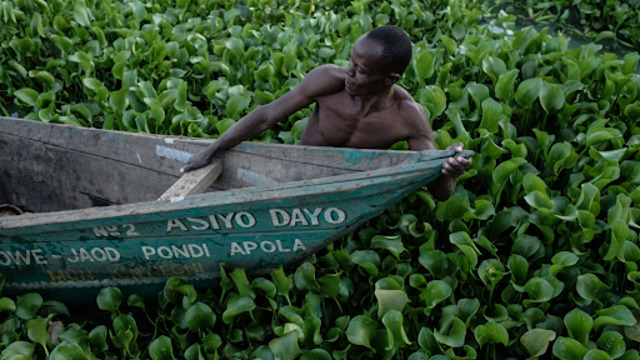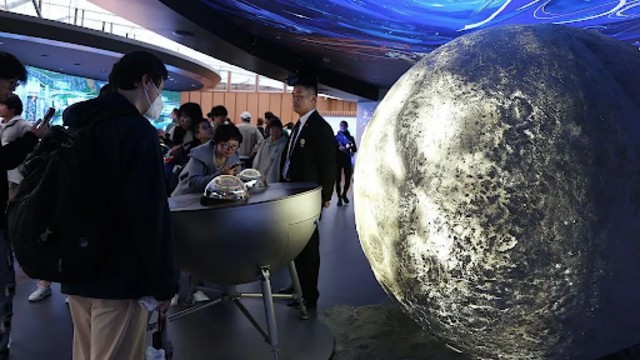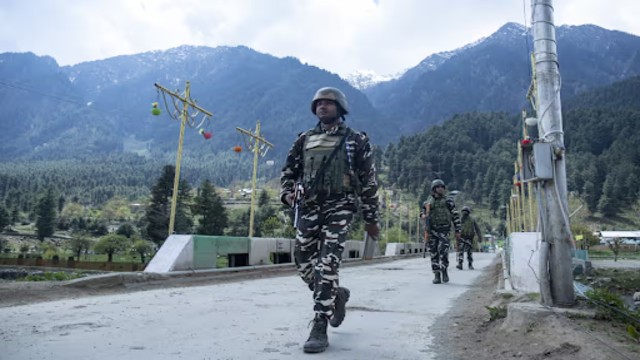
In a 2018 photo, a fisherman battles to make his way through the waters of Lake Victoria, another Kenyan lake overwhelmed by water hyacinth. CNN
Lake Naivasha, located northwest of Nairobi, Kenya, is grappling with an overwhelming invasion of water hyacinth, a fast-spreading plant that is choking its waters. The situation has reached a crisis point, making the lake nearly impossible to navigate and threatening local fish populations. Fishermen like Simon Macharia have faced severe disruptions in their daily routines due to the invasive plant.
Macharia recalls one particularly dangerous incident when fishermen were trapped on the lake for three days due to the dense water hyacinth. “Sometimes it becomes very serious,” he said. The floating weeds not only cause physical entrapments but also wreak havoc on the aquatic ecosystem. Water hyacinth blocks sunlight and outcompetes other plants, starving the water of oxygen, making it increasingly difficult to catch fish. Even the equipment, such as fishing nets, can get trapped, leading to financial losses for the fishermen.
The problem is so vast that it can be seen from space. Originating in South America, water hyacinth was introduced to many regions as an ornamental plant. However, it has since spread uncontrollably, becoming an invasive species across continents. This floating weed impacts more than just local fishing; it threatens industries, disrupts hydroelectric power generation, and even clogs irrigation systems, costing the global economy hundreds of millions of dollars each year.
The situation is especially dire in Africa. According to a 2024 report by an international biodiversity body, the plant has expanded rapidly due to factors like climate change and land use changes. Efforts to address the problem have included introducing weevils to control the spread and using the plant to produce biofuels. However, a Kenyan company, HyaPak Ecotech Limited, has found a more innovative solution.
Joseph Nguthiru, the founder of HyaPak Ecotech Limited, holds one of the company’s seedling bags made from water hyacinth gathered from Lake Naivasha. CNN
Founded by Joseph Nguthiru, a former environmental engineering student, HyaPak turns the invasive water hyacinth into biodegradable plastic. The idea was born after Nguthiru and his classmates experienced firsthand the effects of the plant on a field trip to Lake Naivasha in 2021, where their boat became trapped by the thick mats of water hyacinth. Determined to find a solution, Nguthiru developed a bioplastic made from dried water hyacinth mixed with binders and additives. The resulting product decomposes over a few months, offering a sustainable alternative to plastic packaging.
Kenya, which implemented a ban on single-use plastic bags in 2017 and expanded the ban to include plastics in protected areas in 2020, faces an ongoing plastic pollution issue. Nguthiru’s product addresses this problem by providing a biodegradable alternative. “Most single-use plastic products tend to have a lifespan of about 10 minutes after they come out of supermarket shelves,” Nguthiru said. “So why not make them biodegradable?”
In October 2020, residents of Kihoto estate, located along Lake Naivasha in Kenya, found water hyacinth reaching their doorsteps after heavy rainfall caused the lake’s water levels to rise. CNN
HyaPak’s innovative solution has gained recognition, winning awards such as the Youth category at the East Africa Climate Action Awards and the Prototype for Humanity Award at the COP28 climate conference. Fishermen like Macharia are now harvesting the invasive plant, drying it, and selling it to HyaPak, providing them with an additional income source during days when the lake’s fish stocks are depleted by the weeds.
Nguthiru’s company is also part of Kenya’s reforestation efforts, providing biodegradable seedling bags for a large-scale initiative to plant 15 billion trees by 2032. These bags decompose naturally, releasing nutrients back into the soil, and they also help conserve water, reducing the amount of irrigation needed for seedlings.
With plans to expand to countries like India and El Salvador, where water hyacinth is also a problem, HyaPak is setting a global example of how invasive species can be turned into valuable resources for both the environment and local communities. As Nguthiru puts it, “We are the ones who are going to live with a planet that’s beyond 1.5 degrees Celsius. It’s up to my generation to come up with solutions for the climate crisis.”















